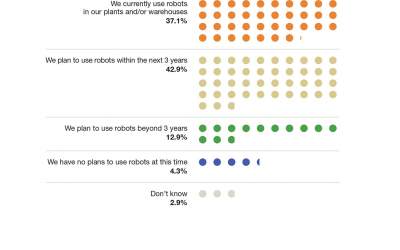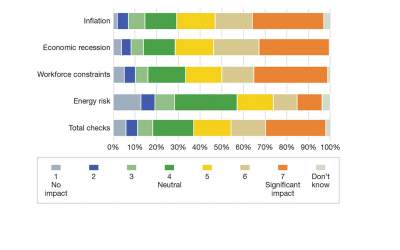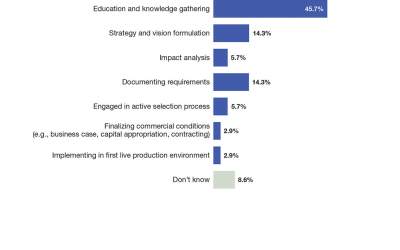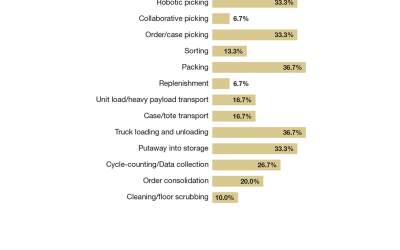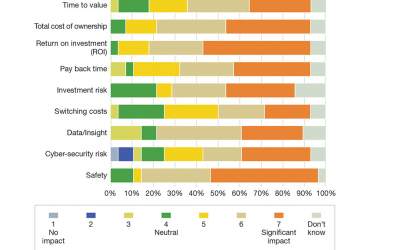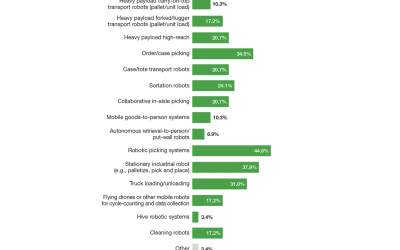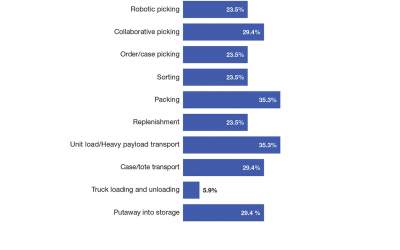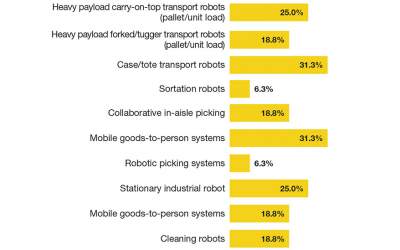More robots are coming to a warehouse near you
Our new Intralogistics Robotics Study proves just how vital robotics and automation are becoming to warehouses and DCs of all sizes—and across all industries.
If we needed more proof that the world’s warehouses and DCs are being equipped with more robots and automation, then ProMat 2023 definitely sealed the deal.
Sprinkled among the many different “traditional” materials handling vendors on the exhibition floor—and in some cases, integrated right into those vendors’ own booths—was an amazing number of advanced robotics solutions that a record 51,000 show attendees “oohed and aahed” over during the show’s four-day run.
The ongoing worker shortage, growth of e-commerce, pressure to “do more with less,” and the advancements we’ve seen in warehouse robotics over the last couple years are only some of the reasons more companies are interested in or investing in robotics for their fulfillment centers.
By 2026, research firm Gartner predicts that 75% of large enterprises will have adopted some form of intralogistics smart robots, which it defines as cyber-physical robotic automation that’s primarily aimed at warehouse and DC environments.
According to Mordor Intelligence, the warehouse robotics market was valued at $9.9 billion in 2021 and is on track to exceed $23 billion by 2027. Using the Industrial Internet of Things (IIoT) and connected systems, companies are using robotics to tackle a number of tasks, including material batching, picking, ordering, packaging, warehouse security and inspection.
Coming out of the 2023 ProMat event, where we saw thousands of attendees evaluate new robotic solutions, Peerless Research Group (PRG) set out to gauge current adoption rates and learn more about how companies are using intralogistics robotics in their operations in our new “Intralogistics Robotics Study.”
Who’s using robotics?
Nearly 200 Logistics Management and sister publication Modern Materials Handling readers provided input for the online survey, which was largely focused on the current state of robotics automation adoption and use cases.
Responsible for hiring, interviewing or sourcing full-time or part-time labor to manage materials handling, distribution and/or fulfillment, the survey respondents work in manufacturing (39%), transportation and warehousing services (10%), and retail trade (14%) industries. Specific to manufacturing, 21% of respondents work in the food, beverage and tobacco sector; 11% in textiles and apparel; and 9% in automotive and transportation equipment.
For this survey, the key industry sectors represented include fabricated metals, industrial machinery and plastics and rubber. The majority of companies (38.8%) have annual revenues of less than $50 million, while 11.2% have somewhere between $100 million to $249.9 million in revenues. Another 9.2% work for organizations that reported revenues of $2.5 billion or more.
Survey respondents hold a range of positions from corporate management (23%) to plant manager (13%), to logistics director or manager (13%), to purchasing or procurement (7%), to industrial engineers (7%). Thirty-nine percent of them are either potential buyers or current users of robotic automation systems and/or services, while 12% are sellers of robotic automation systems and/or services and 9% provide robotic automation consulting and systems integration services.
More robotics, please
A growing number of companies are interested in using more robots and automation in their DCs and warehouses. According to our survey, nearly half (43%) of companies plan to use robots in their facilities at some point within the next three years. Thirty-seven percent have already made a move in this direction, and another 13% plan to start using robots by 2026 or later.
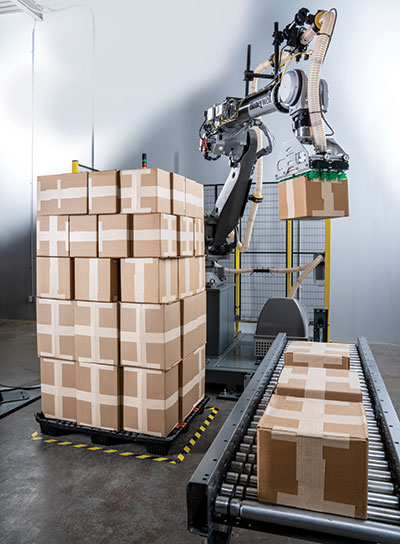
A stunning 4% of readers said they have no plans to use robots in their warehouses. That number fell significantly compared to a similar survey last year, when 40% of survey respondents said they have “no plans to use robots at this time.”
When asked to share their main reasons for not investing in robotics, respondents to the 2022 survey cited warehousing and storage; order customization; inventory management; and individual pick, pack and ship as their biggest hang-ups. Other obstacles included a lack of management support, too many variables in products, space and cost constraints, and inventory fluctuations. It appears that at least some of those hurdles have come down over the last year.
According to this year’s survey, the majority of companies (63%) are currently using or considering other types of large-scale intralogistics automation like conveyors, sortation, storage/retrieval or shuttle systems, while 21% are not using this type of equipment in their operations.
Facing economic headwinds
When it comes to economic factors impacting operations over the next two years, 33% of responding companies expect significant impacts as a result of inflation, while 32% are concerned about an economic recession, and 34% see workforce constraints as an ongoing problem for their companies over the next 24 months. About 19% of respondents feel their organizations are very well positioned to address workforce constraints.
When asked about the current state of their organization’s pursuit of robotic systems in their warehouses or DCs, 46% of respondents that plan to implement robots in the future say they are in the “education and knowledge” gathering stage, and 14% are in the “strategy and vision formulation” phase. Another 14% are documenting requirements and others are currently focused on impact analysis (6%), the active selection process (6%), finalization of commercial conditions (3%) or are implementing their first robots in the live production environment (3%).
Addressing key constraints
The most popular use cases for robotics today are packing (35%), unit load/heavy payload transport (35%), collaborative picking (29%), put-away to storage (29%) and case/tote transport (29%). Other use cases include robotic picking (24%), order/case picking (24%), sorting (24%) and replenishment (24%).
In most cases, companies invest in robotics with the goal of reducing labor costs; increasing flow and throughput; and addressing labor shortages and availability constraints.
Asked about their top reasons for using robotics, respondents said the primary use cases included truck loading and unloading (37%), packing (37%), robotic picking (33%), order/case picking (33%) and put-away to storage (33%).
Other companies want to use robotics for cycle-counting/data collection (27%), order consolidation (20%), unit load/heavy payload transport (17%) or case/tote transport (17%).
Of the top robotic automation systems that companies will be evaluating over the next three years, robotic picking systems (45%), stationary industrial robots (38%) and order/case picking systems (35%) hold the top spots on respondents’ wish lists right now. Other companies are interested in truck-loading/unloading (31%), sortation robots (24%), heavy payload high-reach systems (21%), case/tote transport robots (21%) and collaborative in-aisle picking systems (21%).
Return on investment
Forty-one percent of survey respondents say they would prefer to buy the entire robotic solution as a pure capital expense (capex) with both hardware and software, while 38% would prefer a robot-as-a-service model (pure operating expense, or opex). Fourteen percent want to buy their robots outright and then subscribe to the software-as-a-service (SaaS) model.
Fourteen percent of companies currently have funding for a robotic automation system initiative. Another 45% don’t have the funding in place yet but say the process is underway, while 38% have no funding available for a robotics initiative.
Half of the respondents who are planning to implement robotic automation say that return on investment (ROI) is extremely important to them when choosing a robotics solution, while an equal number of respondents say safety is a top concern. Thirty-nine percent of them say total cost of ownership (TCO) is extremely important.
Streamlining warehouse processes
Over the next three years, 35% of companies are considering using robotics for order/case picking and an equal number are considering case/tote transport robots or robotics for truck loading and unloading. Other companies would like to implement autonomous retrieval-to-person or put-wall robots (29%); mobile goods-to person systems (24%); or robotic picking systems (24%).
About 35% of companies that have already deployed robotics are now planning to pursue new robotic automation use cases and are already making moves in this direction. Additionally, 29% say their new projects are already underway and 24% say they have no current plans to pursue other robotic use cases.
The additional robotics use cases that are being explored include replenishment (31%); unit load/heavy payload transport (31%); goods receiving and unloading (25%); packing (25%); and case/tote transport (19%).
What’s ahead?
Over the next two to five years, the primary types of robotic automation systems that companies will likely invest in include case/tote transport robots (31%), mobile goods-to-person systems (31%), heavy payload carry-on-top transport robots (25%) and stationary industrial robots (25%).
An equal number of survey respondents (19%) will be evaluating heavy payload forked/tugger transport robots, collaborative in-aisle picking robots, mobile goods-to-person systems and cleaning robots over the next two to five years.
When selecting these and other robotics solutions, the top business factors that organizations will consider include ROI (which 56% of companies consider extremely important), time to value (44%), TCO (31%), payback time (31%) and investment risk (31%).
Asked whether their current intralogistics robotics met these objectives, survey respondents were positive. For example, 67% of them say their time to value and investment risk objectives were met, while 53% say the TCO aligned with their expectations. Just more than half (53%) of intralogistics robotics users say their ROI goals were met, and 27% said those goals were exceeded once the equipment was put in place and implemented.

Article Topics
Peerless Research Group News & Resources
40th Annual Salary Survey: Salary and satisfaction up 2024 Outlook Survey: Cautious, But Seeking Efficiencies Top 20 Warehouses 2023: Demand soars, mergers slow 2023 Warehouse/DC Operations Survey: Automating while upping the performance 32nd Annual Study of Logistics and Transportation Trends: Navigating a shallow pool of resources More robots are coming to a warehouse near you 40th Annual Quest for Quality Awards: Service stars in the new era of collaboration More Peerless Research GroupLatest in Logistics
Understanding the FTC’s ban on noncompetes UPS rolls out fuel surcharge increases U.S. rail carload and intermodal volumes, for week of April 20, are mixed, reports AAR Baltimore suing ship that crashed into bridge, closing port, costing jobs Intermodal growth volume remains intact in March, reports IANA Descartes announces acquisition of Dublin, Ireland-based Aerospace Software Developments Amid ongoing unexpected events, supply chains continue to readjust and adapt More LogisticsAbout the Author
Subscribe to Logistics Management Magazine

Find out what the world's most innovative companies are doing to improve productivity in their plants and distribution centers.
Start your FREE subscription today.
April 2023 Logistics Management

Latest Resources


